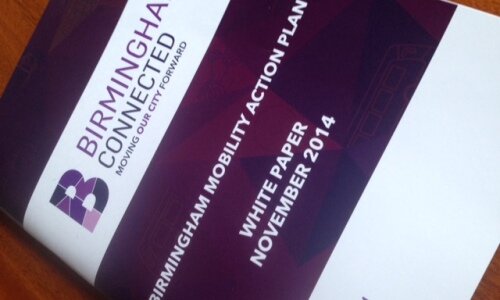
Doubts grow over viability of £4bn Birmingham Connected transport plan
A 20-year vision to transform public transport in Birmingham remains largely aspirational and its success may depend on generating funding through taxes on businesses and obtaining EU grants, a senior city council officer has admitted.
Ann Shaw, head of transportation, faced repeated demands from scrutiny committee members to explain how and when key elements of the Birmingham Mobility Action Plan – now known as Birmingham Connected – would be delivered against a climate of reduced public spending for the foreseeable future.
The total cost of the plan, including reopening local rail routes, building new tram lines, providing sprint bus services, upgrading Snow Hill Station and removing the A38 Queensway tunnels, is £4 billion. The council has identified only £700 million so far.
Ms Shaw accepted that a central plank of the vision, introducing a London-style pre-payment ‘Oyster’ card that could be used on Birmingham’s buses, trams and trains, depended entirely on co-operation from de-regulated private sector transport operators and she could give no assurances that such a system would be approved.
She admitted that a 2021 deadline to re-open the former Camp Hill rail line was unlikely to be met.
There are also problems about obtaining ERDF funding for transport projects because the European Union does not regard Local Enterprise Partnerships as accountable bodies through which money can be channeled.
Ms Shaw said her vision was to deliver a “go anywhere transport system accessible to all”.
She added: “It will no longer be a barrier for people who do not have a car. They will be able to move efficiently around the city on an integrated transport system.”
Asked whether Birmingham Connected was little more than an unaffordable wish list of grand projects, Ms Shaw replied: “This is a 20 year vision. If we don’t put in what we want to do over 20 years then we won’t attract funding.”
Transportation scrutiny committee chair Victoria Quinn told Ms Shaw that the proposed Oyster card was a “gold plank” of Birmingham Connected, but it was difficult to see how such a system could be introduced. Some aspects of Birmingham Connected appeared to be a “shopping list”, Cllr Quinn added.
Cllr Tristram Chatfield (Lab) said: “We have talked about this (multi-modal ticketing) for years and it has not happened. It’s not happened because companies aren’t interested in doing it. We need something to make sure they play ball with us and work with the Integrated Transport Authority.”
Ms Shaw accepted that efforts over many years to bring bus and train companies on board had failed. However, she added: “I am determined to bring multi-modal ticketing into this region. The same card for every type of transport mode you are to choose. We need to carry on discussions about how we can do it.”
On the subject of a workplace parking levy or some other form of congestion charging, Ms Shaw said: “A conversation still has to be had about what we can raise locally in terms of taxes and how we can use support from Business Improvement Districts.
“A parking levy is just one of a number of options around how we can raise additional funding. It will be subject to ongoing discussions with businesses.”
Sir Albert Bore, the leader of Birmingham city council, has said he believes businesses will agree to a levy because tackling congestion is key to attracting inward investment and economic recovery.
But Birmingham Chamber of Commerce chief executive Jerry Blackett has set out his opposition to congestion taxes and the idea will also be opposed by Birmingham’s opposition Conservative councillors.
Cllr Tim Huxtable, shadow cabinet transport spokesman, said: “This would place additional costs on to businesses and would be a major disadvantage to business start-ups.”
Proposals in Birmingham Connected definitely funded include improvements to Snow Hill Station, metro extension to Centenary Square, improved passenger links between New Street and Moor Street stations, new cycle routes, development of 20mph zones and improvements to the Birmingham ring road.
Some other projects, including a metro extension to Eastside and re-opening the Camp Hill rail line depend on obtaining funding from the HS2 Connectivity Package.
Similar Articles
Rogers retires early 0
Birmingham city council has this afternoon confirmed that Mark Rogers will be taking "early retirement"
Panel: Council’s financial plans still at ‘considerable risk’, as Rogers remains on ‘annual leave’ 0
The Birmingham Independent Improvement Panel (BIIP) today publishes a letter to the Secretary of State
Street commits to ‘brownfield first’, but housing could be biggest political challenge 1
Protecting the West Midlands Green Belt from residential development is at the heart of Andy
Business rates revaluation – or making Team Trump look like a ‘fine-tuned machine’ 0
As a former Secretary of State for Culture, Media & Sport, the now Communities Secretary
Political leaders look to hold ‘heads above water’ on land supply 0
It seems like a lifetime ago, given developments at Birmingham city council over the weekend,
About Author










